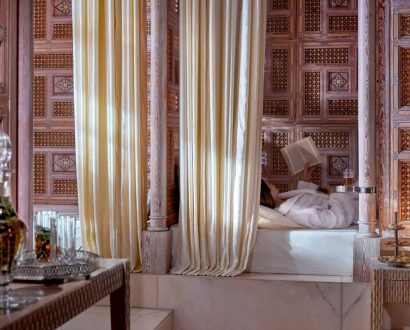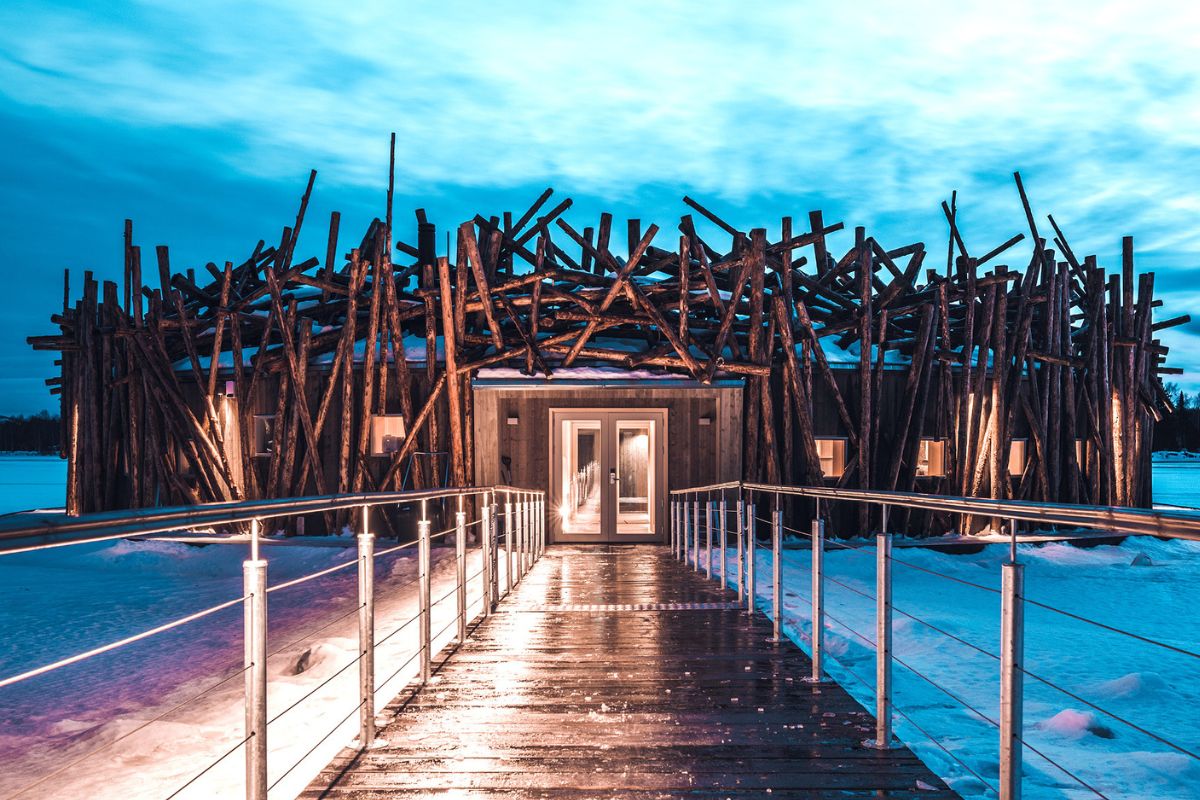Why these luxury hotels are reaping the benefits of ancient wellness rituals

What did you do on your last vacation? Checked into a yoga retreat? Took to a meditation program? Perhaps you went one step further and detoxed by giving up both carbs and technology – all in the name of wellness, of course.
Hoteliers are constantly seeking out ways to allure, engage and entice guests to linger in hotels and think of their properties as more than just places for slumber.
Remember when hoteliers stepped up their culinary prowess and partnered with Michelin-starred chefs? And have you noticed more hoteliers adorning their walls with Picassos and Cezanes, doubling up their hotels as self-guided art museums to keep guests entertained with their own private art collection on display in hotel lobbies?
The next bold move by hoteliers involves heightening wellness experiences beyond regular deep-tissue massages and self-guided sessions in steam rooms.
Post-pandemic, the yearly American Express 2023 Global Travel Trends Report shows continuous interest from travelers wanting to seek more holistic and activity-driven holidays that are designed for those who want to do it all: connect with nature, participate in community-driven social projects and immerse oneself in culturally-enriching projects.
With the wellness industry being incredibly fickle, hoteliers are looking to history for guidance and using ancient wellness rituals to pique guests’ interests. Both cookie-cutter and boutique hotels are strengthening their wellness programs to take advantage of the predicted US$1.5 trillion wellness industry.
Building upon a retreat-like atmosphere, wellness programs in luxury hotels are enlisting sauna experts, yoga gurus and Ayurveda specialists to heighten the hotel guest experience.

Hoteliers are looking to history for guidance and using ancient wellness rituals to pique guests’ interests.
No ancient ritual is sacred, with hotels such as the Four Seasons and Rosewood using tech to deliver ancient rituals including acupuncture.
In Europe, boutique hoteliers are calling upon Mother Nature to help sell their wellness programs, with natural therapies catering to a new mainstream crowd of zen-seeking enthusiasts and not just ‘hipsters’ as it was in the past.
With the latest wellness trend possibly fueled by the COVID-19 pandemic and people’s desire to get back to basics, hoteliers are moving quickly to meet public interest.
While the wellness industry is rapidly growing with a surge in luxury hotels offering ancient wellness programs, how wellness is perceived and achieved still remains subjective and the industry remains trend-based, with celebrities and health gurus dictating and setting the narrative – making it a risky business and investment.
Yet, despite so much at stake, hoteliers find the gamble well and truly worth it when it comes to combining the US$228 billion luxury hotel industry with the trillion-dollar wellness industry.
Hippocrates perhaps said it best: "Foolish the doctor who despises the knowledge acquired by the ancients." And who is brave enough to refute history and our ancestors when it comes to good health and longevity? Definitely not these hoteliers.
Hammam, Morocco
Owned by the King of Morocco, the Royal Mansour pampers guests like royalty in what many regard as the country’s most luxurious hotel.
Combining old-world Moroccan charm in a contemporary setting fit for kings and queens, Royal Mansour perfects the thousand-year-old art with experts guiding guests on how to master the ceremony correctly with Hammam specialists on call.
With the hotel’s wellness space consisting of a three-story riad including a roof terrace, plunge pool and multiple living rooms dedicated to wellness, the award-winning designer atrium is unmistakably Moroccan despite its flamboyantly Moorish and modernized architecture.
Housing both local traditions and the latest innovations in the spa industry, including technologically advanced slimming cell stimulating LPG Endermologie techniques, guests have a choice to immerse in both old world and new world wellness activities for mental and physical strength.
Temazcal Ceremony, Mexico
Cacao and Temazcal ceremonies have been around for centuries. They originate back to Mayan and Aztec traditions in both Central and South America for spiritual, medicinal and ceremonial purposes to promote clarity, creativity and focus.
At Andaz Mayakoba, guests have a series of ancient Yalan wellness activities and practices to choose from, led by the resort’s resident shaman.
New this year, the Naum Spa in the Andaz Mayakoba resort allows guests to customize their own rituals with locally sourced ingredients including melipona honey and cacao, both of which have been used by the Mayan people.
A short walk away from Andaz Mayakoba is Rosewood Mayakoba. At this ultra-luxury resort, guests can opt for a session in an indigenous Temazcal sweat lodge for an exclusive shaman-led, pre-Hispanic healing ceremony to detoxify both body and mind.
Both hotels offer skin care and body treatments to culminate their Mayan experience to meet the expectations of loyal hotel guests.
Cold Water Bathing, Sweden
Dating back to the Vikings era, cold water bathing (kallbad) has long been seen as a healing ritual in Scandinavia, which rose to fame during the spa resort boom in Sweden in the 1970s.
However, despite all the hype and Swedish doctors touting both the mental and physical health benefits associated with plunging into an icy subzero climate lake, the trend fell out of fashion a decade later with sun-loving Swedes swapping ice baths for sunbathes in the Mediterranean.
During the pandemic, a renaissance saw Swedes rekindle their love for cold-water bathing, with major cities like Gothenburg joining in the hype by renovating and revitalizing public bathing pools to meet the demands of residents.
Designer boutique hotels like Arctic Bath in Lapland and Pater Noster, a former lighthouse turned boutique hotel, opened during the pandemic and have wellness programs catered specifically to ice-water bathing, which of course is best chased with a session in a hot Swedish sauna.
Forest Bathing, Germany
Forest bathing, popularized in Japan in the 1980s and commonly known as Shinrin-yoku, is actually rooted in German traditions.
Dating back to the 19th century, history will tell you that therapist Sebastian Kneipp instilled both hydrotherapy and forest bathing (waldeinsamkeit) as a means to heal the body and cure it physically from any ailments.
The activity of isolating in the forest, followed by floating in a nearby mineral-rich lake, is heightened in Baiersbronn, one of Germany’s certified luftkurorts – government approved fresh air and pure water locations.
Brenner’s Park-Hotel and Spa, with its private wellness center Villa Stephanie, is considered one of the pioneers in wellness. It incorporates ancient wellness rituals in a luxury setting overseen by Harry Konig, a specialist in European tech-driven acupuncture and holistic treatments.
A typical Brenner’s program includes Kneipp hydrotherapy, acupuncture and also regular forest bathing in the nearby woods of Baden-Baden, which can be reached by foot directly from the luxury hotel most frequented by celebrities.
Finnish Sauna, Finland
While sauna culture is nothing new and is perhaps the most popular form of therapy found in leading hotels around the world, luxury hotels and resorts in Finland are bringing back the rustic sauna experience for guests to really appreciate the fine craft of taking a sauna.
Surrounded by Mother Nature and with an old-fashioned löyly – hot steam rising from a stove – a surge in luxury hotels across the country are epitomizing what is considered a simple weekly activity embraced by both young and old Fins.
In Lapland, Northern Senses offers a private sauna and outdoor sauna for guests to get back to nature. Meanwhile, in Pyhä, Lapland, lakeshore saunas are found in all 17 suites of the lakefront Kurulas Hotel.
Järvisydän resort in Lakeland also has suites with private saunas for guests who want to further recuperate sore muscles after other ancient rituals, including Tibetan sound sessions and Spanish siestas.
Ayurveda, India
Ayurveda is one of the most well-known traditional medicines native to India. It has traveled to all corners of the world and is now found in leading luxury hotels stretching from the United States to Switzerland.
However, for the ultimate experience, Ananda in the Himalayas is hard to beat with the Himalayan Mountains being the birthplace of India’s ancient practices of yoga, meditation and Ayurveda.
A solid mix of holistic therapies are offered at Ananda, with signature wellness programs to elevate your state of wellbeing, including oil massages (Abhyanga), body purification therapies (panchakarma) to restore balance in the digestive system, as well as age-defying treatments (Rasayana) to boost the immune system naturally.
Balneotherapy, United Kingdom
With high-priced wellness rituals found in many luxury wellness spas, the simple art of taking a bath has also become something of a trend with luxury hotels riffing off ancient bathing culture popularized by the Romans and Greeks.
Balneotherapy dates back to 300BC, however, a handful of European cities popularized the therapy centuries later to ride off tourism booms in their cities. Towns such as Baden-Baden in Germany, Budapest in Hungry and Bath in the United Kingdom were able to profit off their location and having direct access to thermal waters rich in minerals – believed to have healing powers to repair the body naturally after a long soak.
In the United Kingdom, The Gainsborough Bath Spa resonates prestige and opulence in an 1800 Georgian and Victorian property located in Bath and is the quintessential destination for balneotherapy.
Guests are treated like yesteryear aristocrats, and the hotel is the only establishment to have access to Bath’s original healing waters. It also has modern tech-driven infrared sauna rooms available, so guests who want both modern and historical treatments under the one roof need not to travel to London for up-to-date contemporary treatments.
Fangotherapy, Italy
Fangotherapy is the word used to describe Italy’s connection with mud bathing. Historians have discovered that Cleopatra herself slathered mud from the Dead Sea as part of her beauty regimen, which soon spread during the Roman Empire period.
Research shows that mud bathing can alleviate muscle pains and improve circulation, and Terme di Saturnia in Tuscany is the ultimate destination for fangotherapy. It also offers modern wellness programs including cryotherapy and a healthy round of golf for guests who can’t just lie in mud for four days.
The same muddy experience can be experienced at Switzerland’s leading wellness spa, Chenot Palace Weggis, where mud therapy plays an integral role in the clinic’s seven-day detox program.
Buddhist Living, Thailand
A pioneer in bringing ancient wellness rituals to guests in both cosmopolitan cities and countryside retreats, hotel group Anantara has incorporated wellness into its luxury hotel portfolio since its first property opening in Thailand’s Hua Hin in 2001.
Within its global network of luxury hotels is Anantara Siam Bangkok Hotel, which offers ancient Thai rituals for early risers who want to do more than sun salutations in the morning.
A series of activities believed to replenish the mind, body and soul begin at the crack of dawn and start with daily Buddhist-led living rituals and traditions like Tak Bart – offering food to the Gods, which is followed by morning strolls and ancient Chinese qi gong classes to round off the holistic experience as an Anantara guest.
Guests can choose to end their stay with a Thai massage or visit nearby Vivid Drip bar for the latest IV-drip and anti-aging treatment currently trending in the wellness space.
Michelle Tchea is the owner of Chefs Collective, an organization working with the world's greatest chefs and luxury hoteliers. She is the author of five bestselling books on gastronomy, wellness and luxury travel and has contributed to Conde Nast Traveler, Time Magazine and SCMP.